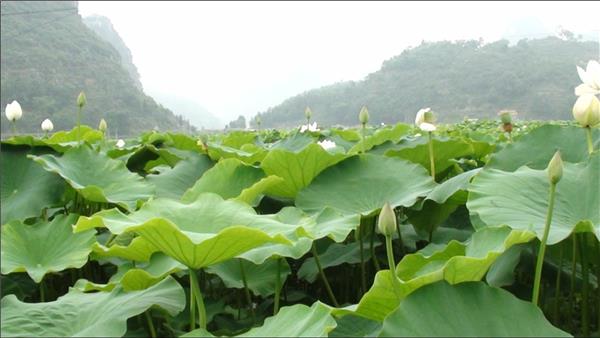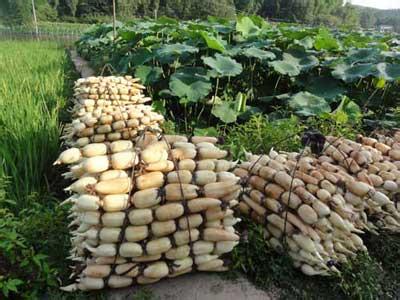How to grow lotus root
Lotus root is a kind of low-fat food with high nutritional value, which can be eaten raw, cold, steamed, stewed, stir-fried and braised. Lotus root is rich in vitamin C and crude fiber, which can not only help digestion and prevent constipation, but also supply carbohydrates and trace elements needed by the human body, prevent arteriosclerosis, improve blood circulation, and is beneficial to health. It is generally recommended to eat lotus root 3 times a week, dinner is the best, lotus root and ribs soup, after eating can improve sleep quality. So what is the planting technology of lotus root?

Planting techniques of lotus root
1. Water management: Lotus root is an aquatic plant, which is inseparable from water during the whole growing period. Summer is the peak growth period of lotus root flowers, and the demand for water is also the greatest, so it is necessary to pay attention to the fact that there can be no water in the pond throughout summer. The foliar spraying of new high-fat film can enhance the green and luxuriant branches and leaves, and enhance the accumulation and directional transport ability of photosynthesis products.
2. Fertilizer management: Lotus root likes fertilizer and has more demand for fertilizer, but too much fertilizer will burn seedlings, so it is necessary to apply thin fertilizer frequently, spray new high-fat film to greatly improve the utilization rate of effective components of fertilizer, not afraid of sun exposure and evaporation, and can adjust the absorption of water-saving.
3. Pest control: aphids, Spodoptera litura, Spodoptera litura and so on. Endanger standing leaves and buds. Targeted medicine spraying plant surface with new high-fat membrane can improve the efficacy, effectively prevent virus infection in leaves, and make branches and leaves green and luxuriant. Water maggots suck the juice from the roots, stems and leaves of lotus roots and can be killed with lime. Lotus root pond can also be used to cultivate Loach, Loach feces can be used as lotus root fertilizer, Loach can also eat lotus root pond pests, Loach in the lotus root pond can also loosen the soil.
4. Growth period: the quality of lotus root is very high. Spraying Diguo Zhuangtiling can thicken the nutrient transport conduit of underground fruit, improve the swelling vitality of ground fruit, make the lotus root fat, crisp and tender, more and sweet moisture, high quality and high yield, with delicate flavor.

Technical points of planting Lotus Root in low-lying Field
Planting lotus root in paddy fields, especially in low-lying fields, the output value per mu is several times higher than that of planting rice, which is an ideal choice for farmers to get rich.
1. Select fields for ploughing: choose fertile sandy loam low-lying fields for planting. After ploughing the fields planting lotus root, 2000-3000 kg of organic fertilizer such as human and animal manure were applied per mu, and the fields were retted for half a month.
two。 Planting at the right time: choose improved varieties of white lotus root or red lotus root and plant them before "sting". When planting, the row spacing is 1 m × 1.4 × 1.5 m, and there are more than 3 nodes in each section of lotus root. During planting, the shallow water layer of 5 × 6 cm is maintained in the field, the head of the lotus root is inclined and buried in the mud, and the end of the lotus root is slightly above the water surface.
3. Heavy application of base fertilizer: when ploughing and planting, 30 kg of phosphate fertilizer and 30 kg of peanut bran were applied per mu, and the first topdressing was carried out when 2 or 3 leaves came out of the water, urea 8kg / mu and potash fertilizer 10kg / mu. At the beginning of lotus root, 1000 kg of pig and cow manure was applied per mu.
4. Strengthen management: pay attention to mid-ploughing and weeding in the early stage, keep 12-15 cm water layer in the field, drain dry water before topdressing each time, and pour it back to the original water layer after fertilization. When the leaves are all over the field, you should check the edge of the field and lead the dense lotus root whip to the sparse place, so that the distribution is uniform and the growth is robust.

Management of pond lotus root
1. Water layer management: master "shallow-deep-shallow" in principle. After planting, in order to increase the ground temperature during the day, maintain 3-5 meters of shallow water, but encounter a cold current and low temperature at night, we should irrigate about 10 meters of deep water to prevent cold and maintain the ground temperature. Generally add water twice a season, when the water level of rainstorm is high, the drainage hole can be used to adjust the water level. When the temperature is high, the water layer can be deepened to 15-20 cm to prevent high temperature damage. After the Beginning of Autumn entered the lotus root stage, the water level was maintained at 5 cm, especially in the early stage of lotus root formation, so as to keep the paddy field dry in order to "control up and down" to raise the ground temperature.
2. Topdressing: ⑴ seedling fertilizer: 12 kg urea per mu after the standing leaves are exposed to the water. ⑵ application of lotus root fertilizer: 12 kg urea and 12 kg potassium sulfate per mu were applied after the third standing leaf came out of the water, and 12 kg urea and 12 kg potassium sulfate were applied per mu when Lesser Heat's front leaves were yellow or edge curled or when the lotus flower was not bright. Greater Heat could not apply fertilizer in the future.
3. Turning the lotus root head: turning the lotus root head is called the whole lotus root whip. The adjustment of lotus root whip was carried out from the end of June to the end of July, once every 7 days, for a total of 4 times. In the first two times, the new leaves of lotus root should be adjusted less than 60 cm from the ridge of the field. In the last two times, the new leaves of lotus root should be adjusted less than 40 centimeters away from the ridge of the field. The adjustment time should be between 9 am and 9 pm on a sunny day.

3. Picking old leaves and folding flower stalks: when the standing leaves are full, the floating leaves gradually wither, so they should be removed in time, so that the field water can be exposed to the sun as much as possible to increase ground temperature and improve ventilation conditions. When some standing leaves yellowed or withered due to diseases and insect pests or other reasons, they should also be removed. Lotus lotus is for the purpose of picking lotus root, if there are buds, the pedicel should be folded so as not to consume nutrients in flowering. After the production of lotus root is over, about 15 days before harvest, the petiole of lotus leaf on the ground is cut off by irrigation, so that the underground part stops breathing and the commercial value of lotus root is improved.
3. Picking old leaves and folding flower stalks: when the standing leaves are full, the floating leaves gradually wither, so they should be removed in time, so that the field water can be exposed to the sun as much as possible to increase ground temperature and improve ventilation conditions. When some standing leaves yellowed or withered due to diseases and insect pests or other reasons, they should also be removed. Lotus lotus is for the purpose of picking lotus root, if there are buds, the pedicel should be folded so as not to consume nutrients in flowering. After the production of lotus root is over, about 15 days before harvest, the petiole of lotus leaf on the ground is cut off by irrigation, so that the underground part stops breathing and the commercial value of lotus root is improved.
Related
- Wuhan Hospital Iron Tree Blooming Result Was Instantly Frightened by the Gardener Master
- Which variety of camellia is the most fragrant and best? Which one do you like best?
- What is the small blue coat, the breeding methods and matters needing attention of the succulent plant
- Dormancy time and maintenance management of succulent plants during dormancy
- Minas succulent how to raise, Minas succulent plant pictures
- What are the varieties of winter succulent plants
- How to raise succulent plants in twelve rolls? let's take a look at some experience of breeding twelve rolls.
- Attention should be paid to water control for succulent plants during dormant period (winter and summer)
- Watering experience of twelve rolls of succulent plants
- Techniques for fertilizing succulent plants. An article will let you know how to fertilize succulent plants.



